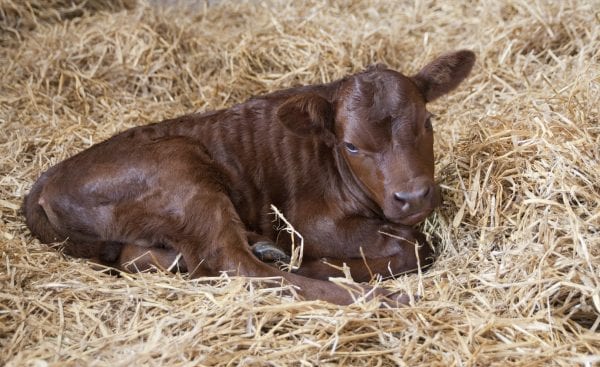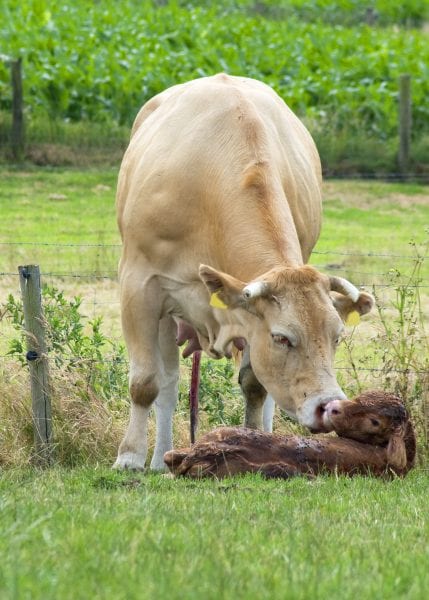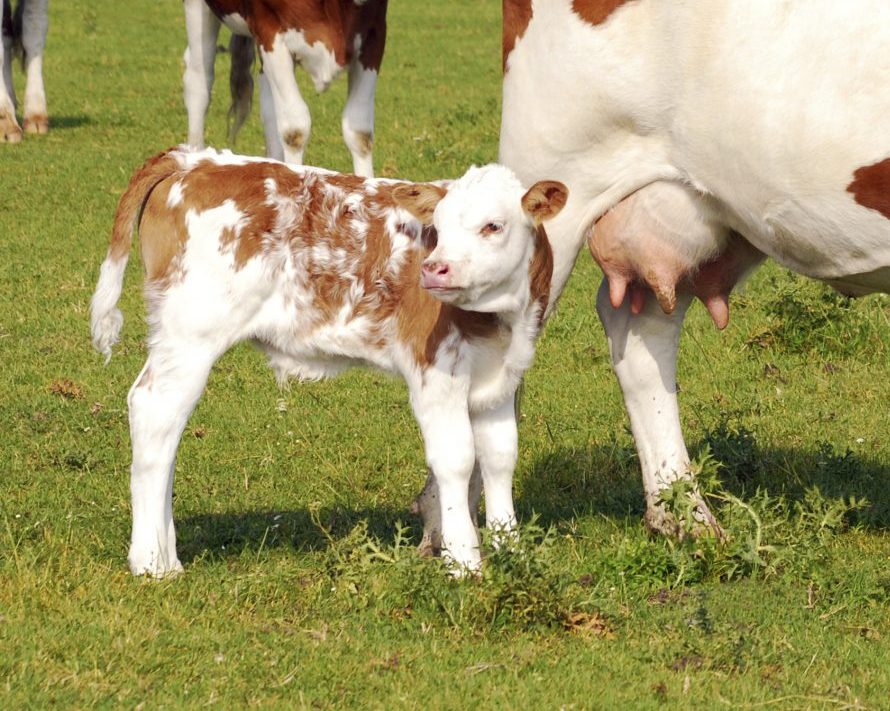Beef

Cows and heifers can experience multiple complications before, during, and after calving, and each complication can have negative short- and long-term reproductive consequences if not handled properly. This publication focuses on some common complications that can occur with cows and heifers before and after calving. To learn about the sequence of events during a normal calving as well as how to prepare for the calving season, see extension publication ANR-1403, “Managing a Successful Calving Season.”
Reproductive Tract Prolapses
One of the most common complications associated with calving is a reproductive tract prolapse, which occurs when a portion of the reproductive tract is pushed out of the body.
There are three types of reproductive tract prolapses: vaginal, cervical, and uterine. vaginal and cervical prolapses usually occur prepartum (before calving) during the last half of pregnancy but occasionally occur postpartum (after calving). They typically occur in cows but occasionally occur in heifers as well.
Vaginal and cervical prolapses are classified as follows:
- 1st Degree – intermittent protrusion of the floor of the vagina, which occurs when the cow is lying down and then corrects itself when the cow stands up
- 2nd Degree – continuous protrusion of the vagina even when the cow is standing
- 3rd Degree – continuous protrusion of the vagina and cervix (cervical prolapse)
- 4th Degree – a 2nd or 3rd degree prolapse that has been prolapsed so long the tissue is becoming necrotic (dead)
Vaginal and cervical prolapses will reoccur, and they are heritable; therefore, it is best to have your veterinarian temporarily fix the prolapse with the intent of culling the cow and her heifer offspring. Do not let a cow or heifer calve before having sutures used to fix the prolapse removed, or major injuries to the cow or heifer can occur.
 A uterine prolapse always occurs postpartum and is usually associated with cows in poor condition and/ or those that have had dystocia (a difficult delivery) that resulted in poor uterine and cervical contractions after calving. These animals also often have low blood calcium levels.
A uterine prolapse always occurs postpartum and is usually associated with cows in poor condition and/ or those that have had dystocia (a difficult delivery) that resulted in poor uterine and cervical contractions after calving. These animals also often have low blood calcium levels.
A uterine prolapse is much more dangerous than a vaginal or cervical prolapse and must be treated as an emergency. Contact your veterinarian immediately. Cows with a uterine prolapse will die without prompt medical attention.
If a uterine prolapse occurs, restrain and/or contain the animal so that she cannot run or move excessively and hemorrhage. Be careful not to overly stress a cow with a uterine prolapse, and do not attempt to move her unless absolutely necessary—and then not very far. It is best to treat the cow on the farm if possible. If transport is necessary, be extremely careful. A cow with a prolapsed uterus is often in shock and at great risk for fatal hemorrhaging.
If the cow survives treatment, she will likely develop a temporary uterine infection and be slower to rebreed, but she is not at any greater risk for uterine prolapse in subsequent years. Uterine prolapse is not a heritable condition and will not necessarily reoccur; therefore, there is no need to cull the cow as long as she rebreeds.
Differentiating Between a Vaginal/Cervical Prolapse and a Uterine Prolapse
If a reproductive tract prolapse occurs before calving, it is a vaginal/cervical prolapse. If a reproductive tract prolapse occurs after calving, it can either be a vaginal/ cervical prolapse or a uterine prolapse, but it is most likely a uterine prolapse. If the prolapsed tissue has caruncles on it, it is a uterine prolapse. Caruncles occur where the placenta attaches to the uterus and are raised bumps on the uterus. They are darker than the surrounding tissue, circular to oval in shape, and approximately 2 to 4 inches in diameter.
Retained Placenta
 Another common calving complication is a retained placenta, which occurs in 3 to 5 percent of all calvings. The bovine placenta is normally expelled within a few hours after calving but is considered a retained placenta if the afterbirth is not expelled within 12 hours. If your herd is experiencing a more frequent occurrence than the typical 3 to 5 percent, it would be a good idea to reevaluate your herd management program. Cows with retained placentas are often slower to rebreed.
Another common calving complication is a retained placenta, which occurs in 3 to 5 percent of all calvings. The bovine placenta is normally expelled within a few hours after calving but is considered a retained placenta if the afterbirth is not expelled within 12 hours. If your herd is experiencing a more frequent occurrence than the typical 3 to 5 percent, it would be a good idea to reevaluate your herd management program. Cows with retained placentas are often slower to rebreed.
Predisposing factors for retained placenta are as follows:
- Premature induction of parturition (calving) greatly increases the incidence of retained placentas. Fortunately, there is rarely a need to induce in cattle.
- Abortion or premature birth increases the likelihood of a retained placenta to 15 percent if the birth occurs within 121 to 150 days of gestation and 50 percent if it occurs within 240 to 270 days of gestation. If it occurs before 120 days of gestation, there is little likelihood of a retained placenta.
- Dystocia (difficult births).
- Poor body condition or obesity.
- Nutritional deficiencies, especially hypocalcemia, or low blood calcium, cause the uterine contractions that are necessary to expel the placenta to weaken. Other nutritional factors that increase the likelihood of a retained placenta include deficiencies in energy or protein, vitamin A, selenium, iodine, and vitamin E.
Treatment for Retained Placenta
If a retained placenta occurs, do not forcefully pull out the placenta because this may leave pieces of the placenta in the uterus, which will further delay the cow from rebreeding. The recommended treatment for a retained placenta is to let mother nature take its course, and eventually the placenta will fall out. This may take up to a week (and will smell bad), but be patient. Watch the cow closely to ensure that she is eating, drinking, and feeling healthy.
A retained placenta does sometimes result in a severe uterine infection called metritis, which can make a cow very sick. If not treated correctly and in a timely fashion, the metritis may release bacterial toxins that can lead to death. When in doubt, call your veterinarian.
Conclusion
Maintaining the reproductive health of a herd is essential to the economic viability of a cow-calf operation. Therefore, prompt attention to common reproductive complications encountered before and after calving is important. Failure to provide proper care may jeopardize future reproductive success.
Reviewed by Soren P. Rodning, Extension Specialist, Associate Professor, Animal Science and Forages, Animal Sciences; Michelle F. Elmore, Extension Specialist, Animal Science and Forages, Animal Sciences; and Kim Mullenix, Extension Specialist, Assistant Professor, Animal Science and Forages, Animal Sciences; all with Auburn University
Originally by Soren P. Rodning, Michelle F. Elmore, W.F. Owsley, Extension Animal Scientist, Associate Professor, Animal Sciences; Misty Edmondson, Professor, Food Animal Medicine and Surgery, Clinical Sciences; Julie A. Gard, Professor, Food Animal Medicine and Surgery, Clinical Sciences; all with Auburn University; and Andrew Lovelady, Associate Professor and Director of Clinical Programs, Tuskegee University College of Veterinary Medicine
Reviewed October 2021, Common Complications With Calving, ANR-1404

